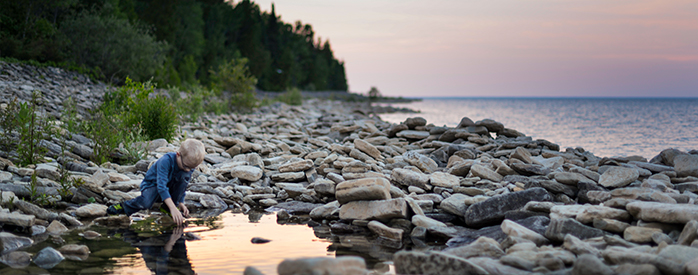Water

We Love Michigan’s Water
Here in Michigan, our lakes, rivers and streams define us. We are beachgoers, anglers and stone skippers. We love our Great Lakes State, and we work to protect its precious water sources. All while delivering the energy our customers count on.
Most of our water use stems from steam electric generation. So, we have cut back and recycled water whenever we can at our existing plants. We also put water conservation first when we consider new generation sources.
Our fossil-fueled power plants use water for cooling, condensing and reusing steam to spin our turbines and generate electricity. We’re making a big impact by closing our remaining coal-fired plants as part of our Clean Energy Plan. By 2026, we will reduce our water withdrawals by 98% as compared to the 2012 level.
But our efforts to conserve water don’t end there. We have started on alternative water use initiatives, such as:
- Retrofitting equipment at our hydroelectric plants to eliminate water use for noncontact cooling purposes.
- Installing low-flow water fixtures at all new facilities and as existing facilities are renovated.
- Using air or nitrogen for pipe pressure testing rather than water when it’s safe to do so.
- Reducing water through bentonite clay slurry reuse systems for horizontal directional drilling projects. This lets us reuse water rather than using the full amount of fresh water we need.
We also put water conservation first when we consider new generation sources. That means developing ways to avoid or reuse and save water at our facilities and near gas and electric distribution sites.
Monitoring Water Quality to Protect Aquatic Species
For more than 100 years, we have harnessed the power of water to produce clean and renewable energy. We operate 13 hydroelectric plants along five rivers. These plants include Au Sable, Manistee and Muskegon. Water is also the key energy source for the Ludington Pumped Storage Plant. This plant runs on water from Lake Michigan that’s stored in a 27-billion-gallon reservoir. The plant has been called one of the world’s biggest electric batteries because it can store a ton of energy to deliver to our customers at any moment.
The health of fish and other aquatic animals is one of our top priorities near our dams and all rivers. To make sure we keep aquatic life healthy, we regularly monitor water quality in our reservoirs and downstream from our hydroelectric facilities. We want to ensure water temperatures and dissolved oxygen levels remain at healthy levels.
At some reservoirs, cold and oxygen-saturated water is in short supply at the end of a long, hot summer. So, we have installed special equipment called an upwelling system. It uses compressed air to draw colder water from the bottom of the reservoir, which passes through the hydro plant and cools outflow waters. Thanks to these and other measures, Michigan’s rivers are home to blue ribbon trout and some of the best tailwater trout fisheries in the eastern U.S.
We also play a key role in Great Lakes water conservation issues through continued participation in State of Michigan work groups and international commissions. This includes representing Michigan electric and natural gas energy companies at the Michigan Department of Environment, Great Lakes and Energy’s Water Use Advisory Council.
Water Conservation
We have set goals to improve our water stewardship practices. These include reuse and recycling options for projects with water requirements as well as managing our water-heavy systems to have as little runtime as possible.
Our water reduction targets show that we are moving toward a companywide water stewardship culture change. This helps us lessen the environmental impacts of our operations and find opportunities and benefits of analyzing water-risk activities.
Water use intensity is a measure of the rate of water use in gallons per megawatt-hour of electricity generated. We are clear in how much water we use to power Michigan. Fluctuations in water intensity can occur due to increased dispatch of our generating facilities and unit outages. By 2026, when our last coal-fired plants are expected to close, we believe we will reach an overall water intensity reduction of 97%, compared to a 2012 baseline.


We have also saved hundreds of millions of gallons of water through our conservation efforts. In fact, a goal was set in 2018 to save 1 billion gallons of water over a 5-year period. This goal was not only met but achieved a full year ahead of schedule in 2021. In 2022, we set an additional 5-year goal to reduce water use by 1.7 billion gallons from 2023 through 2027. In 2023, Consumers reduced water use by more than 660 million gallons towards this goal.
For more specifics on our water use and trends, review our CDP Water Report.
For the best performance on this website and others, please upgrade your browser. For suggestions to find the best web browser for you click here.

